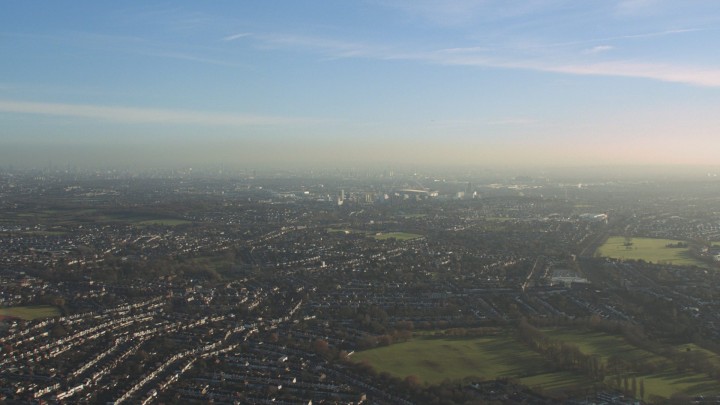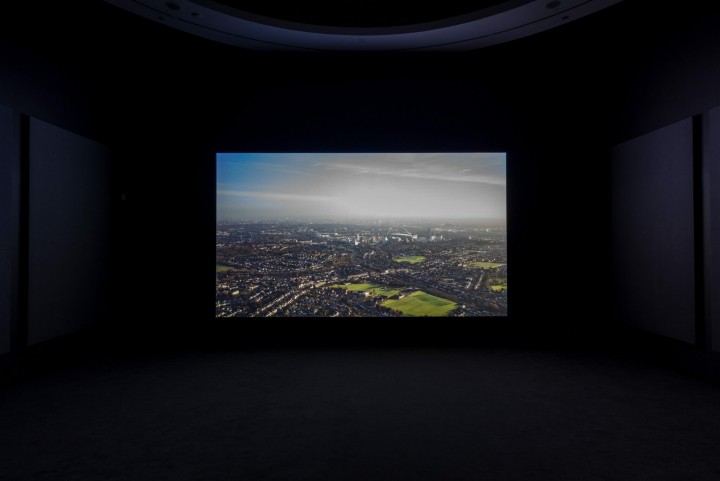Scottish Art News
Latest news
Magazine
News & Press
Publications
Steve McQueen: Grenfell
By Patricia-Ann Young, 03.04.2025

We float above on a beautiful day, drifting over a leafy suburb somewhere in London. We glide deeper and deeper into the capital, towards our inevitable destination, as the sound of birdsong and swaying trees gives way to the steady thrum of a busy city.
Everything seems peaceful and as it should be, but we know where we are going, and we know that it is not. Our pace over the city is slow and steady, almost boring – but then we see it on the horizon. Part of the landscape of London, but… off. When we move closer, we can see this imperfection more clearly. The early evening light falls on the white of the surrounding towers, making them golden, but Grenfell is a void. Tall, charred and blackened, it is not beautiful, but an unmistakable, grotesque symptom of a disease under the skin of London, the UK – maybe even the whole world.
In a letter to introduce this film, director Steve McQueen wrote that he was afraid that people would forget Grenfell Tower once it was covered with wrapping and scaffolding, hiding it from public view. He was determined to stop that from happening, so filmed the tower while its burnt carcass was still exposed for all to see.
 Install photo by Richard Ivey. Steve McQueen Grenfell 2019 still courtesy the artist
Install photo by Richard Ivey. Steve McQueen Grenfell 2019 still courtesy the artist
McQueen’s anger in the film is cold and merciless. The sound cuts out once we reach the tower, and the camera circles it over and over, moving in to allow the viewer to see every terrible detail up close, before pulling out wide, and then swooping in again. The experience is hypnotic, rhythmic – and relentless.
From a distance, Grenfell Tower looked like a sandcastle made of ash, something that could be easily blown away or pushed down, an unsightly smudge quickly removed and easily forgotten about. But up close, you see every melted contortion, every gaping window, every barren floor empty of life. It is impossible not to imagine the people trapped there in the early hours of Wednesday 14th June 2017. There are images in this film that you will carry with you for a very long time.
The Grenfell fire was the result of wilful neglect, when corporations knowingly put greed before human life. It was a terrible crime that still no one has answered for, and we are unlikely to see justice for the 72 people who died anytime soon. Recommendations from a Government Inquiry to remove dangerous cladding from other at-risk buildings still has not been implemented, meaning a similar tragedy could happen again.
McQueen forces us to look, look and look again, even when all we want is to look away. And the longer you look, the more the disturbing it becomes. With every turn the camera takes around the tower, some new horrible little detail of destruction catches your eye. How can it be almost eight years, and no one held accountable? Corporations are made up of people after all – how can those people live with themselves, after putting out disinformation and PR spin to save their own skins?
The film was privately shown first to bereaved families and survivors and then was then presented at Serpentine in London’s Kensington Gardens. It is now on tour, visiting five partner institutions across the UK, including Glasgow’s Tramway.
To see the film, you walk in through one door to the auditorium and walk out another to leave. On your way out, the names of 72 people who were killed that dreadful night are emblazed on a white wall with black lettering. Every single person had a beautiful, valuable life that will never be replaced. Take strength from your own cold fury – and never, ever look away.




